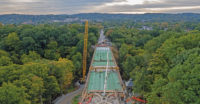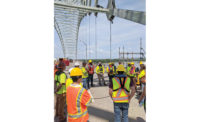Related Article:
After Pittsburgh Bridge Collapse, Fast-Rising Replacement Emerges
Back to:
25 Top Newsmakers
The sudden collapse of Pittsburgh’s Fern Hollow Bridge early on Jan. 28, 2022, gained national attention, occurring the same day as a pre-planned visit to the city by President Joe Biden and just weeks after Congress passed the $1.2-trillion Infrastructure Investment and Jobs Act, in part to restore the safety and integrity of aging U.S. transportation systems.
Already set to discuss infrastructure needs, Biden revised his schedule to visit the wreckage before returning to Washington and vowed the bridge would be rebuilt.
That promise was fulfilled last Dec. 23, with the opening of a new Fern Hollow Bridge. Along with restoring a crossing that carried up to 19,000 vehicles daily prior to the collapse, the new structure eliminated a detour that, while temporary, still complicated key transit routes and compromised response times for emergency services. Accomplishing such an accelerated, high-profile assignment illustrated the communication, mutual trust and teamwork among the Pennsylvania Dept. of Transportation’s state and regional representatives, and the design-build team of HDR Engineering and Swank Construction.
Time wasn’t the only constraint the project team had faced. Other issues needed to be addressed, such as the proximity of historically significant buildings at the entrance to an adjacent park and the need to create an access along a steep slope for cranes that would install structural elements such as 21 bulb-tee beams—each 4 ft wide, 8 ft tall and weighing 110 tons—making them the largest in western Pennsylvania.

Chad J. Basinger, Swank’s project manager, credits the project’s success to “the assembly of a dedicated team that was well-versed in the project’s key attributes,” from design specifications and utility relocation procedures to permitting and vendor relationships.
Having design, fabrication, procurement and construction moving parallel through most of the replacement required participants to maintain “a heightened sense of awareness regarding their input into the project,” Basinger adds. “Everyone knew that if they came back to the table with a change or significant impact, that it might undermine weeks of effort.”
Basinger also stresses that the project’s multifaceted processes were fast-tracked, but not short cut. “The design was especially compressed but followed the standard of care that would be expected of any project,” he adds. “That really put the pressure on HDR and PennDOT design and construction teams to find solutions that would not compromise the final product or be second-guessed after project completion.”
PennDOT district executive Cheryl Moon-Sirianni says that while the effort was the “epitome of a team project,” Basinger is well-suited to represent the skill and effort of its members. “To obtain the level of success under such challenging conditions, there must be leaders not only who are always there to direct the many players involved in the effort but also who are forced to use their own knowledge, foresight and creativity to face all of the hurdles that arise with a complex project such as this,” she points out.
Basinger “exhibited all of those qualities and many more,” Moon-Sirianni says. “He was always thinking of ways to build the project more efficiently and effectively. We only wish we could have construction leaders like Chad on all of our PennDOT projects.”





Post a comment to this article
Report Abusive Comment